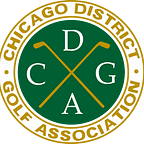2023 CDGA Turfgrass Program Summary Report
Temperatures. For the second summer in a row, we did not see an excessively hot summer. High temperatures about 90 degrees were largely absent. When peak heat did occur, it was short-lived (1 to 4 days) and then would break. However, the end of August did see extreme heat on four consecutive days which broke records. One of the highest heat indices ever observed in Chicago occurred during this period (116°F heat index).
Spring Drought. Chicago District clubs would experience very dry conditions in the spring of 2023. Throughout the Midwest, normal precipitation was absent in both May and June and severe drought was experienced. Beginning the July 4th weekend, a regular cadence of thunderstorms would replenish soil moisture levels by seasons end.
March Turfgrass Seminar on New Golf Course Trends. Saturday, March 25 saw a successful CDGA turfgrass seminar at Midwest Golf House. Approximately 50 attended with 30 via Zoom. For the first time, our attendees included several members of the Canadian Golf Course Superintendents Association (CGSA). Past President Sheldon Solow was the moderator and guest speakers included Zach Nicoludis, USGA Green Section, Doug Myslinski, Wadsworth Golf Construction and Dan Dinelli, North Shore Country Club.
Diagnostic Services. A total of 42 on-sight diagnostic visits occurred in 2023. All are initiated by golf course superintendents. Of all issues, localized dry spot (LDS) was most problematic during this growing season. LDS is an abiotic condition caused by hydrophobic soils that lose their ability to rewet normally. Sand-based root zones (golf greens) are particularly prone to LDS and why wetting agents are now standard applications.
Disease Development Delayed. Normal development of common foliar diseases was delayed until midsummer because especially dry conditions were in place during the spring. In summer, brown patch was more problematic than recent years caused by warm nights and frequent thunderstorm activity (July and August). In September, dollar spot peaked remained the primary disease of creeping bentgrass in 2023. Typical root diseases, such as summer patch of bluegrass, were largely absent in 2023.
New Insect Pest. With the help of Penn State University, we confirmed the presence of a new insect pest in Illinois. It turns out the annual bluegrass weevil, or ABW, had been slowly moving from the Mid-Atlantic region since its first report in New York in 1957. ABW is an exclusive pest of golf courses and we will continue to track its movement within the Chicago District. The Turfgrass Program’s diagnostic service continues to pay dividends.
Lemont Research. In 2023, Shehbaz Singh completed his second year as Manager of Turfgrass Research. Companies that sponsored work has grown to include The Andersons, BASF, Control Solutions, Envu, PBI Gordon, Precision Laboratories and Syngenta. Five studies occurred on the Bob Berry Sunshine Course and focused on the control of weeds and disease. An additional permanent creeping bentgrass variety trial was seeded on August 31. With minimal inputs, this golf green study will evaluate the newest “Super Bents” for their susceptibility to dollar spot. Many bentgrass varieties in this test are experimentals not yet released.
Off-Site Research. In 2023, off-site research was conducted at two locations: Hinsdale Golf Club and North Shore Country Club. At Hinsdale, Pythium root rot was investigated using newer Pythium-specific fungicides on a creeping bentgrass green in play. At North Shore, an extensive amount of fungicide research was focused on dollar spot. The five studies utilized a nursery green, a driving range tee and a fairway in play. A sixth study focused on newer granular products in their ability to control silvery thread moss in a green.
Research Presentations. Shehbaz presented two divot research posters conducted at the Bob Berry Sunshine Course at the annual Crop Science meeting in St. Louis Missouri in November, 2023. The CDGA Green Committee provided the idea for the divot research which was well received. The goal was to find the best way to achieve speedy recovery in a golf tee. One finding stood out. We found chewings fescue seed alone should be considered as a replacement for creeping bentgrass seed. Chewings fescue seed is advantageous: 1) It is a larger seed and is quick to germinate, 2) it acts only as a “nurse grass” and does not persist, and 3) it is a bunchgrass and, unlike creeping bentgrass, will not become an invasive grassy weed if accidentally introduced into a Kentucky bluegrass rough.
Communications. Totaling 31 in 2023, weekly Turfgrass Scouting Reports were written from March to October. These reports continue to provide rapid technical communications on weather, diagnostics and research. In 2023, the reports delivered the discovery of annual bluegrass weevil in Illinois at two locations. Previously this insect pest did not occur in Illinois.
CDGA Golfer Magazine Turf Column. CDGA Green Committee once again identified and then wrote valuable articles on turfgrass topics. The turf column in the CDGA Golfer saw seven articles written from a golfer’s perspective. Designed to provide golfers with timely updates on golf course maintenance practices as they relate to playability as well as the environment.
Hall of Fame. Dr. Randy Kane was inducted into the Illinois PGA Hall of Fame on November 10, 2023 at the Glen Club. He was recognized as both innovative and behind-the-scenes in his role as the CDGA Turfgrass Program Director for 20+ years beginning in 1985. In the United States, it remains unique as no other golf association has one. Today, the CDGA Turfgrass Program is the only research and diagnostic program in the state of Illinois. In November, Dr. Derek Settle wrote the Guest Column for the CDGA Golfer Magazine about Randy Kane. He recalled his first meeting Dr. Kane as a graduate student in the early 2000s. A final sentence summed it up nicely. “To this day, Randy is the CDGA Turfgrass Program Advisor Emeritus — he simply knows too much about greens in the Chicago District.”
